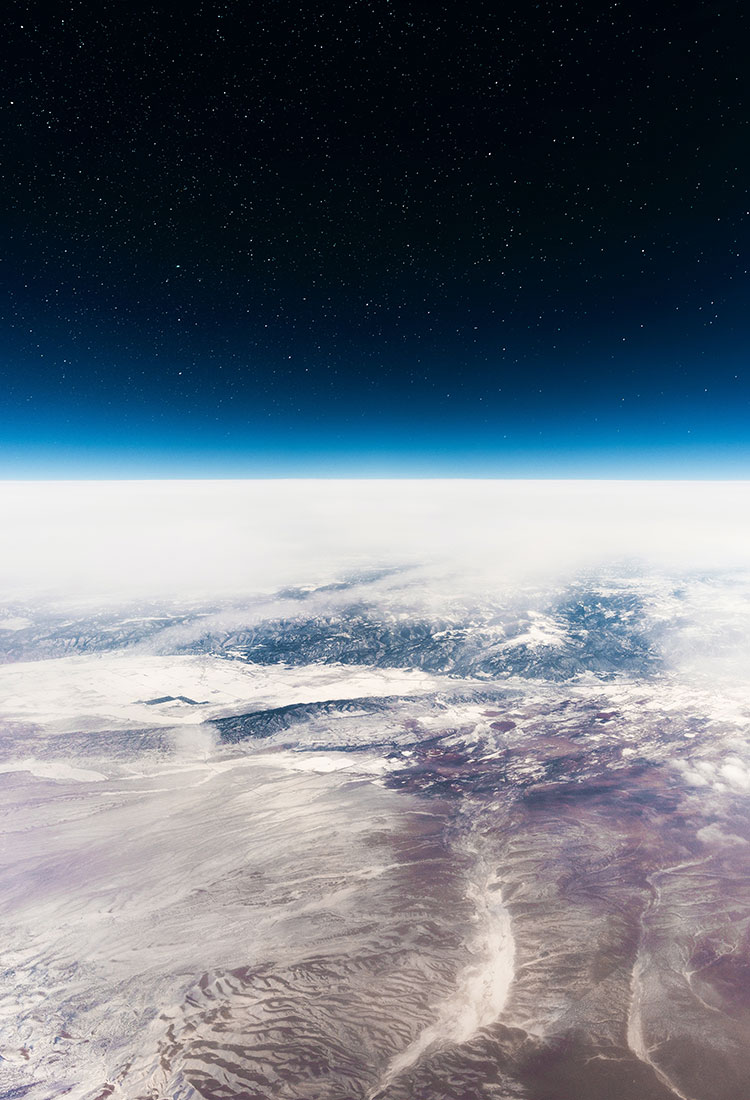Contrary to popular belief, the Great Wall of China can NOT be seen by the naked eye from space, as recently confirmed by NASA. (The famous structure tends to blend into similarly-colored surroundings.) There are, however, many other landmarks around the world — both natural and human-made — that are visible from satellites and space stations orbiting our planet. Thanks to the NASA Earth Observatory, we can get an idea of how they look to astronauts, including those at the International Space Station, which orbits 220 miles above Earth’s surface. From ancient religious monuments to colossal waterways and the world’s tallest mountains, check out these 15 landmarks that can be seen from space.
Suez Canal, Egypt

As far back as 1850 BCE, Egyptian pharaohs built waterways that provided a route from the Red Sea to the Mediterranean via the Nile River. But it wasn’t until 1859 that a 10-year engineering project headed by French diplomat Ferdinand de Lesseps led to the creation of the Suez Canal. The 120-mile-long canal has since been an important trade route between Europe and Asia and cuts out a two-week journey around Africa. About 50 ships pass through the canal each day, carrying everything from animals to cars and food.
Astronauts can clearly observe the Suez Canal and the vast desert landscapes and dense urbanization that frame it. When the Ever Given cargo ship ran aground and blocked the canal’s southern entrance in March 2021, it prevented over 100 ships from passing. These ships showed up like cars on a gridlocked highway on satellite images.
Amazon River, South America
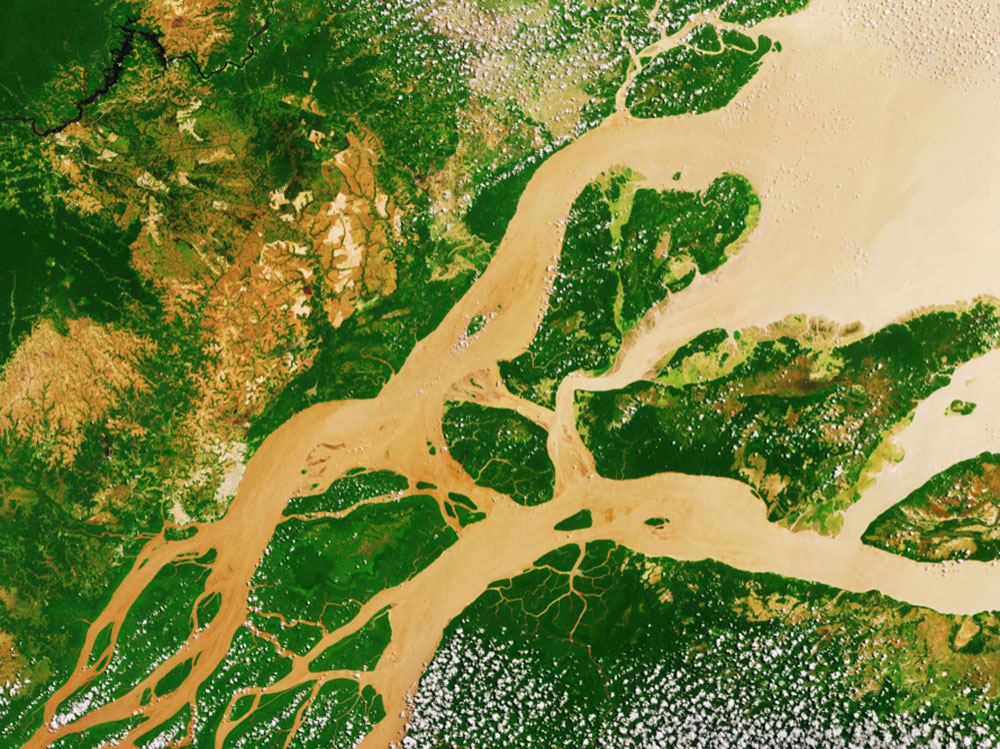
Stretching for more than 4,000 miles, the Amazon River is the world’s second-longest river and its largest by volume — which makes it relatively easy to spot from space. The Amazon begins in Peru’s Andes Mountains and meanders through Ecuador, Colombia, Venezuela, Bolivia, and Brazil before emptying out into the Atlantic Ocean. Traveling from one end to the other is the equivalent of traveling between New York and Rome. The river provides a natural habitat for some 2,500 fish species, including the giant pirarucu and flesh-eating piranha.
Curiously, billions of years ago the Amazon flowed in the opposite direction and at one time even simultaneously flowed east-to-west and west-to-east. Scientists discovered this accidentally while carrying out research on rocks, in order to ascertain the speeds at which sediment flows toward the Atlantic Ocean. It’s just another fascinating fact for astronauts to consider when gazing upon what appears like a sand-hued snake from up in space.
Angkor Wat, Cambodia
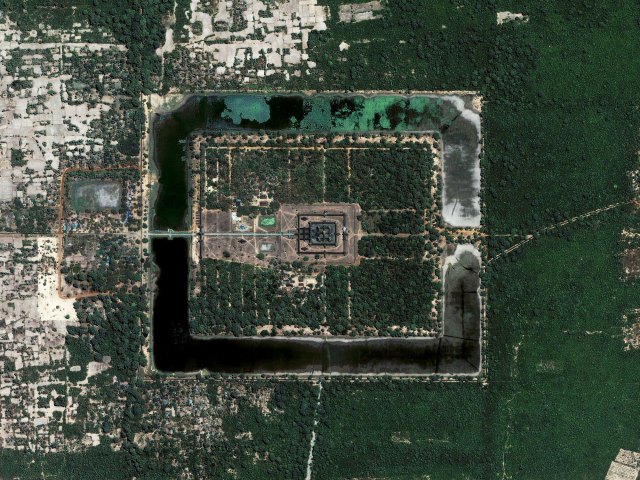
Built in the first half of the 12th century, Angkor Wat is Cambodia’s most famous temple and is widely regarded as the world’s biggest religious monument. It’s so famous that it appears on the nation’s flag. The temple was originally dedicated to the Hindu god Vishnu, but by the end of the 12th century, it was converted into a Buddhist temple. The structure is a symbolic representation of Mount Meru, which is the center of the Hindu universe. Artistic works, such as bas-reliefs that recreate scenes from Cambodian history and folklore, decorate the entire complex.
Even from huge distances, several of the symbolic features of Angkor Wat are visible, including the five towers, which portray the five peaks of Mount Meru. The stepped terraces of the complex represent the mountain slopes, while the moat and defensive wall depict the surrounding oceans and mountain ranges of the Hindu universe.
Ferrari World, United Arab Emirates
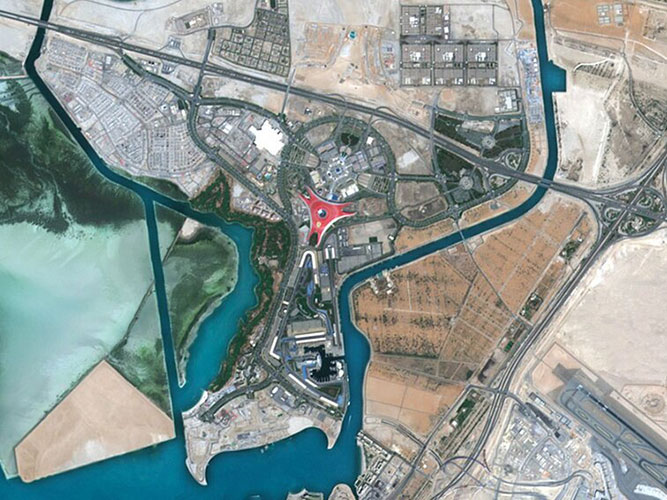
About half a century ago, Abu Dhabi consisted of a few modest settlements dotted across dusty desert landscapes and islands. Today, the city has become known for multimillion-dollar investments in ambitious architectural projects. One of these projects is the Ferrari World Abu Dhabi amusement park on Yas Island, which boasts the world’s fastest rollercoaster and Ferrari-themed simulators.
Much of the entertainment at Ferrari World takes place beneath an enormous structure. The 49-acre curving roof consists of over 13,000 tons of steel and was inspired by the double curve of the traditional Ferrari bodywork. Its bright-red paintwork is obvious to anyone flying over the island, and it’s clear to astronauts, too. In the center of the roof is the largest Ferrari logo in the world.
Golden Gate Bridge, California
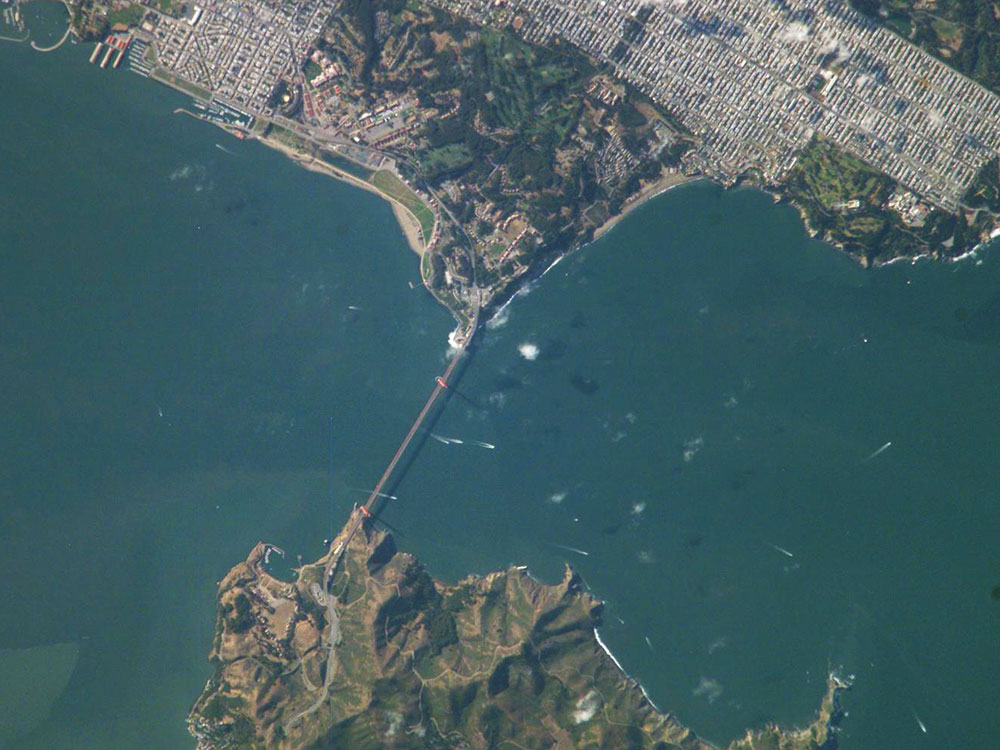
Owing to their distinguishable straight lines, bridges are among the easiest things to spot from space. Humans have been constructing bridges for millennia, and there aren’t many as emblematic as the Golden Gate Bridge, a nearly-9,000-foot, single-span suspension bridge that connects the city of San Francisco with Marin County to the north. Its reddish-orange color was chosen at first by accident, but the bridge’s designer realized it would enhance the visibility of the bridge through the characteristic San Francisco fog.
The winter months, when foggy days are fewer, offer the best views of the bridge from the International Space Station. Astronauts can also spot other landmarks around San Francisco Bay, such as Alcatraz and the San Francisco-Oakland Bay Bridge. At the same time, the gray urban cityscape stands in stark contrast to the green hills surrounding it.
Grand Canyon, Arizona
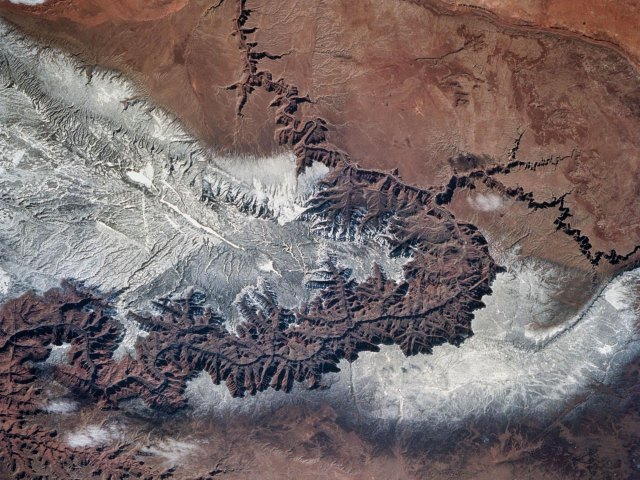
The spectacular Grand Canyon, much of which lies within Grand Canyon National Park, is one of the Seven Natural Wonders of the World. Scientists estimate that it was created sometime between six and 70 million years ago. The canyon is still home to several Native American peoples, including the Hopi, who believe that they emerged from the canyon and that their spirits rest here, and the Havasupai, one of the most remote communities in the U.S.
At 277 miles long, 18 miles wide, and over a mile deep in some places, the Grand Canyon resembles a long, meandering river to astronauts in space. They are one of the fortunate few to see the canyon in its entirety — even helicopter flights only cover small portions of the canyon’s enormity.
Great Barrier Reef, Australia

Set along the crystalline waters of the Coral Sea, off Australia’s northeastern coastline, is another of the Seven Natural Wonders of the World. The UNESCO-protected Great Barrier Reef stretches for 1,430 miles, making it the largest coral reef system on the planet. It’s home to almost 3,000 individual reefs and 900 islands — and shelters 400 types of coral, 1,500 fish species, 4,000 species of mollusk, and over 200 bird species.
What often strikes visitors to the Great Barrier Reef is its kaleidoscope of dazzling colors. These are equally as impressive when looking down from space. Images highlight the crystalline-blue waters peppered with coral reefs, islands, and sandbars. Climate change is an ongoing threat to the reef, and satellite images help researchers monitor its health.
Hingol National Park, Pakistan
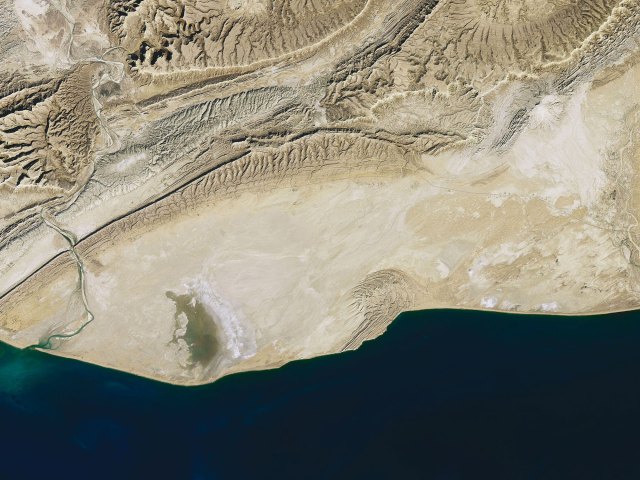
The rocky terrain of Pakistan’s 2,400-square-mile Hingol National Park is reminiscent of lunar landscapes. It’s home to the world’s largest mud volcano and fascinating rock formations such as the Balochistan Sphinx and Princess of Hope. A number of endangered species also call the park home, including the Sindh ibex (wild goat), Balochistan urial (wild sheep), chinkara (deer), and over a dozen types of birds.
In images of Hingol National Park taken from space, the lunar-like topography is clearly distinguishable from the adjacent Arabian Sea. The park’s namesake Hingol River and Makran Coastal Highway appear as lines that snake through the landscape. Also visible, albeit as a small dot, is the Hinglaj Mata Temple, the site of the largest Hindu pilgrimage in Pakistan.
Kennecott Copper Mine, Utah

Open-pit mining is a surface mining method used to extract rocks and minerals (often copper) from the earth’s surface by removing them from an open-air pit. One of the world’s largest open-pit mines is the Kennecott Copper Mine (also known as the Bingham Canyon Mine), situated close to Salt Lake City, Utah. In operation for over a century, the mine measures 2.5 miles wide and has a depth of 3,937 feet, which is over twice the height of One World Trade Center in New York City.
When viewed from the International Space Station, it’s possible to make out some of the most important features of the mine. Among these are the stepped terraces (which range from 52 to 82 feet in height), hills of waste rock, a roadway, and reservoirs. The contoured landscape of the surrounding Bingham Canyon is noticeable as well.
The Himalayas, South and East Asia
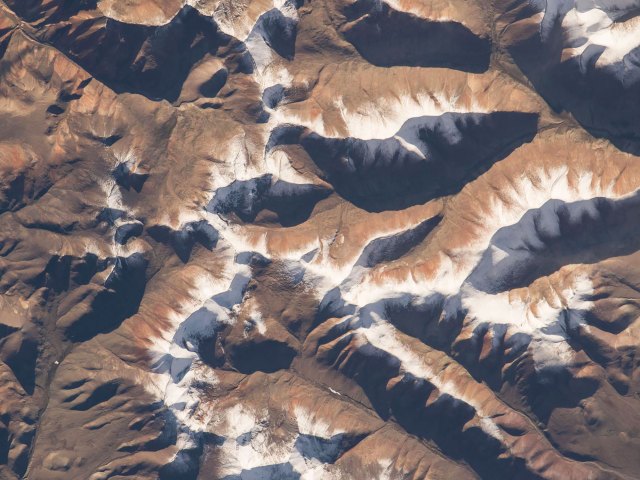
Few mountain ranges are more dramatic than the snow-covered Himalayas. Stretching for about 1,400 miles across Pakistan, India, Nepal, China, and Bhutan, the Himalayas have an average elevation of 20,000 feet, which helps make them visible from hundreds of miles above Earth’s surface. About 75% of the range is located in Nepal, including the 29,032-foot-tall Mount Everest, which towers above the Nepal-China border.
The Himalayas aren’t the only mountain range that astronauts can see: Images of the Andes Mountains, Rocky Mountains, Tien Shan mountains, and Mount Kilimanjaro have all been snapped from space. If you’ve ever flown over mountains in an airplane, the view is similar from space, only a little more miniaturized.
Millennium Dome, England
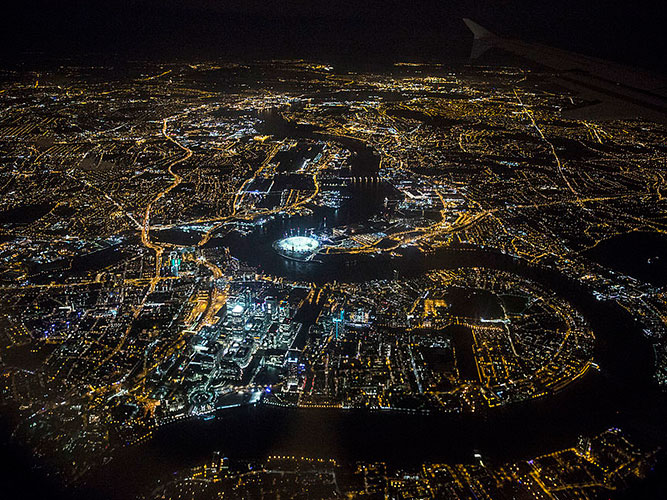
Located along the River Thames in London, the Millennium Dome (which is now the O2 arena) is a government-funded building that was designed to host an exhibition celebrating the start of the millennium. This massive tent-like structure is one of the largest buildings on the planet by usable volume. It stands close to the Greenwich Meridian Line and has a number of time-related aspects: Its 365-meter diameter represents the days of the year, there are 12 masts for each hour of the day, and the maximum height of 52 meters corresponds to the number of weeks in a year.
Since opening as an exhibition center on December 21, 1999, the dome has been featured on The Amazing Race reality competition show, has hosted events during the 2012 London Olympics, and is presently a live music venue. An astronaut looking down on the building might be forgiven for thinking a UFO has landed by the side of the Thames.
Palm Islands, United Arab Emirates
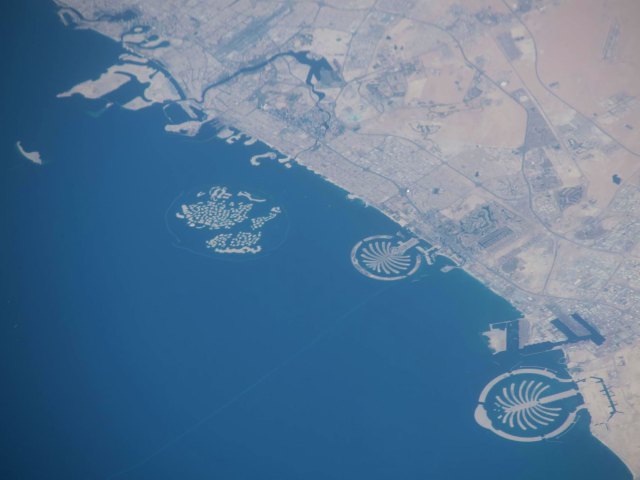
Dubai is no stranger to extravagant landmarks and displays of wealth, and the Palm Islands are a prime example of this. The chain of three artificial islands is among the world’s most ambitious modern engineering projects, which has been ongoing since 2001. So far, Palm Jumeirah is the only fully completed island. It’s the largest artificial island on the planet and roughly 3.9 billion cubic feet of sand were used to create its palm tree shape.
The Palm Islands are just one of several island projects planned for Dubai’s coastline. Another is the World Islands, an archipelago positioned to resemble the world map when seen from above. Another, the Universe, was proposed to recreate the Milky Way and Solar System in the shape of islands. If it goes ahead, it will be possible to see space from, well, space.
Palmanova, Italy
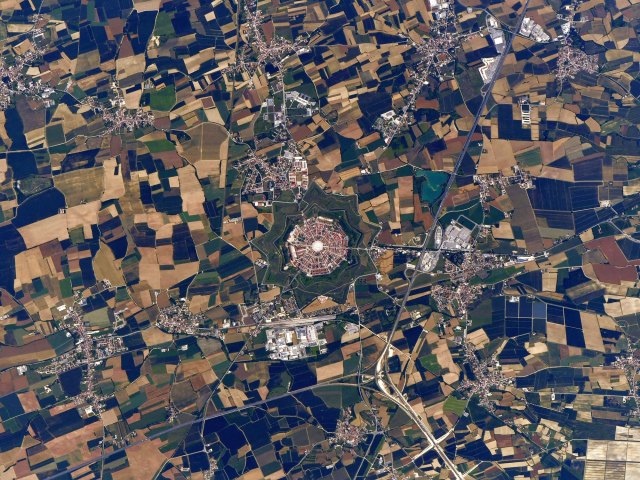
Palmanova, in northeastern Italy, is a masterpiece of Renaissance military architecture that dates back to 1593. The Republic of Venice built this fortress town in the shape of a nine-pointed star to protect themselves from raids by the Habsburg, Ottomans, and Saracens. The distinctive design, which makes it easier to discern from space, features three sets of nine-sided ring roads that encircle a central piazza. Ramparts set between the points of the star are designed to defend their adjacent points when under attack.
The design of the concentric city has close ties with the idea of a Utopian city, which was popular among Renaissance-era artists and philosophers such as Thomas More. But despite its harmonious design, people were initially apprehensive to move here. To increase population, Venice acquitted criminals on the agreement that they would live in the city.
Pyramids of Giza, Egypt
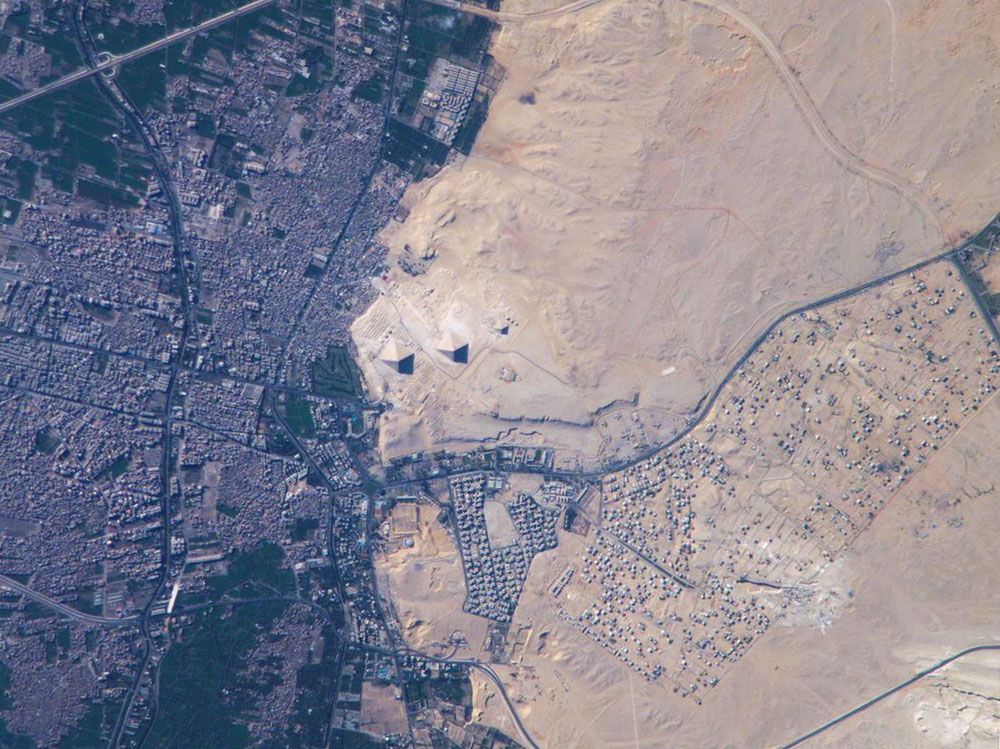
These faultlessly geometric structures were erected by the ancient Egyptians sometime around 2500 BCE as tombs for the pharaohs. How Egyptians managed to pull off such an impressive feat of engineering remains a mystery. Of the three pyramids at the complex, the largest is the 481-foot-tall Great Pyramid of Khufu.
NASA astronauts first photographed the Pyramids of Giza in 2001 from the Space Station Alpha. It clearly shows the Great Pyramid of Khufu lined up alongside the Pyramid of Khafre and the Pyramid of Menkaure. Their proximity to Cairo’s city center is a fascinating juxtaposition of the ancient and modern worlds.
Wadi Rum, Jordan
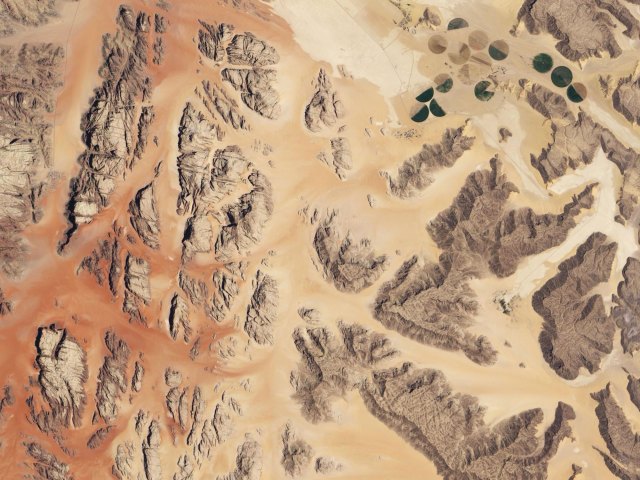
Wadi Rum is a breathtaking valley of canyons, dunes, red sandstone mountains, and ancient petroglyphs. Made famous by British archaeologist T.E. Lawrence during the Arab Revolt, Wadi Rum is now a popular destination for 4WD safaris, camelback rides, rock climbing, and Bedouin-style camping. Jordanians affectionately refer to it as the Valley of the Moon, and it has provided the backdrop for Mars and space-themed movies, including Rogue One: A Star Wars Story and The Martian.
NASA images of Wadi Rum show an arid area with extremely sparse vegetation. The brick-colored valleys and dunes are interspersed by the varying formations of the mountains. It’s another paradoxical example of viewing a space-like scene from outer space.
Featured image credit: Daniel Olah / Unsplash
More from our network
Daily Passport is part of Inbox Studio, which publishes content that uplifts, informs, and inspires.






